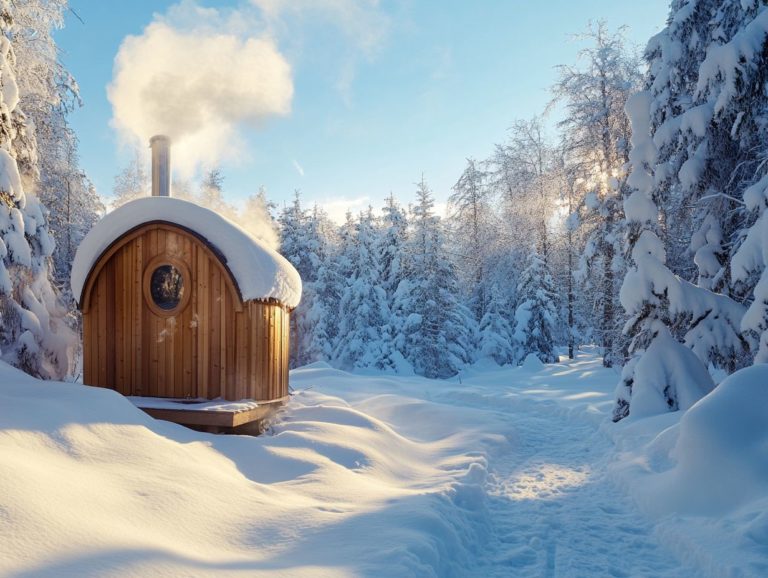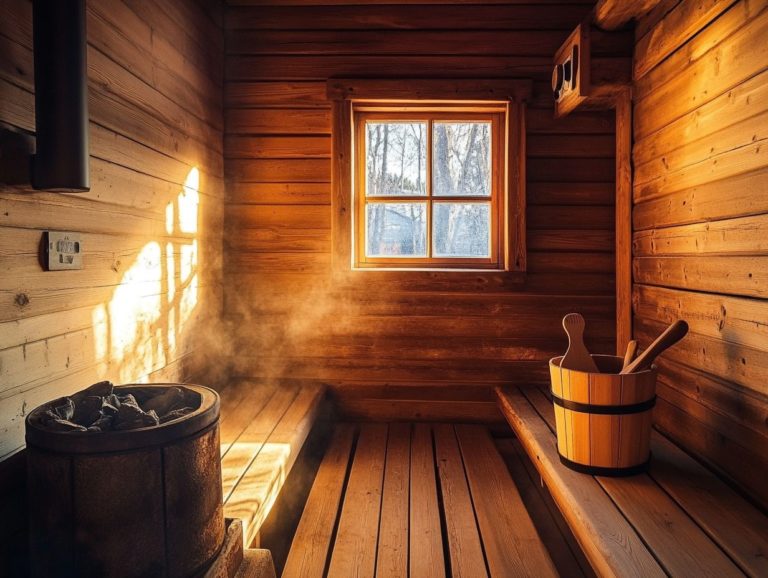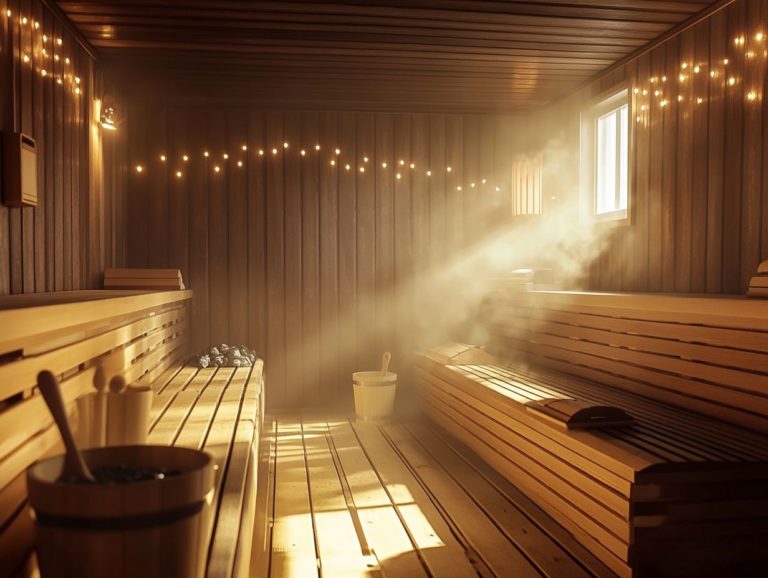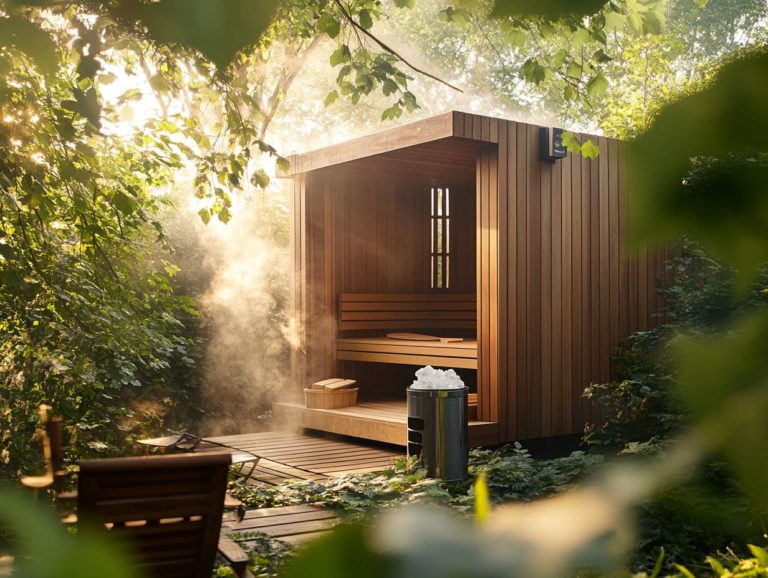The Best Materials for Building a Sauna
Building a sauna is an exhilarating journey, and the choice of materials can profoundly impact your overall experience.
From picking the ideal wood to understanding insulation options, every decision you make is vital for the sauna s efficiency and comfort. This article delves into the various wood types and their benefits, compares traditional and infrared heating methods, and provides insights into essential materials such as benches and flooring.
You’ll also discover expert tips for maintaining your sauna. Immerse yourself in this information to create a sanctuary that perfectly aligns with your needs!
Contents
- Key Takeaways:
- What to Consider Before Choosing Materials
- Wood Options for Sauna Construction
- Insulation Materials for Saunas
- Heating Options for Saunas
- Other Essential Materials for Saunas
- Maintaining and Replacing Sauna Materials
- Frequently Asked Questions
- What are the best materials for building a sauna?
- Why is cedar wood a popular choice for saunas?
- What makes aspen wood a good option for sauna building?
- Can redwood be used for both indoor and outdoor saunas?
- Are there other materials for building a sauna besides wood?
- What should I consider when choosing the best materials for my sauna?
Key Takeaways:
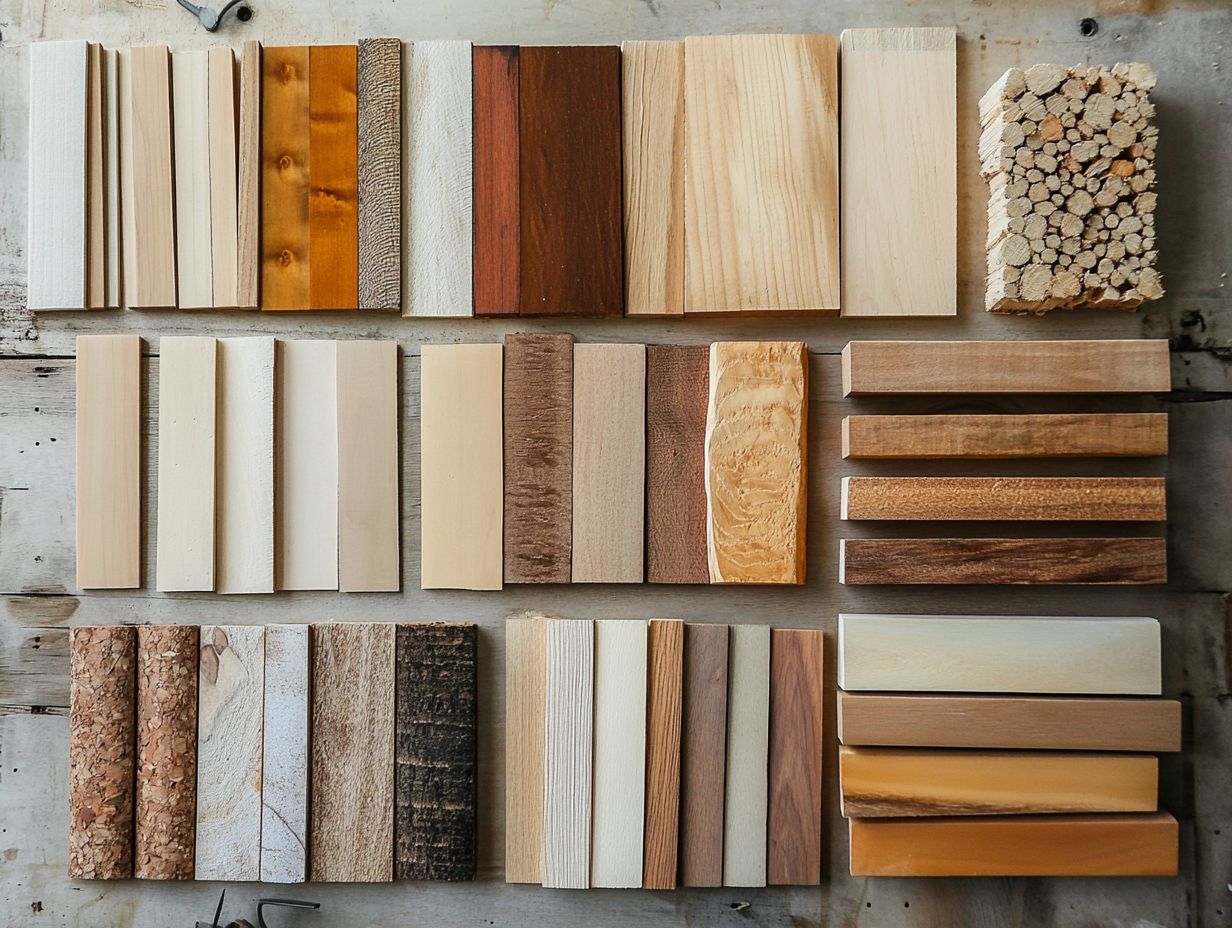
- Choose wood that is durable, heat-resistant, and free of knots for your sauna construction.
- Effective insulation is key to maintaining a comfortable and efficient sauna experience.
- Consider the benefits and drawbacks of traditional and infrared heaters when selecting the best option for your sauna.
What to Consider Before Choosing Materials
As you embark on the journey of creating your ideal sauna, whether you envision a snug indoor retreat or a sprawling outdoor oasis, the choice of materials becomes paramount.
The right materials shape the sauna’s aesthetic appeal and functionality, ensuring its durability and safety.
Select high-quality woods like cedar or poplar, think about insulation types, and use proper moisture barriers. Each step plays a vital role in enhancing your overall sauna experience.
Understanding the costs of sauna construction is crucial, as well as the advantages of different building kits. This knowledge can significantly influence your design and enjoyment.
Wood Options for Sauna Construction
Selecting the right wood for your sauna construction is crucial to crafting that ideal sauna atmosphere. Whether you re leaning towards a classic indoor setup or an inviting outdoor retreat, consider woods like cedar, poplar, and hemlock.
Each wood type brings its unique advantages, from delightful aromas and impressive resistance to high humidity, to striking aesthetic appeal.
Your choice of wood not only elevates the beauty of the sauna but also impacts its durability and upkeep.
Types of Wood and Their Benefits
Different types of wood can significantly enhance your sauna experience, each offering unique benefits tailored to your preferences.
If you enjoy the rich, inviting aroma of cedar, you’ll find it enhances the sensory experience of your sauna sessions and boasts natural antibacterial properties.
If strong scents aren t your preference, hemlock might suit you with its fine texture and low resin content, providing a subtle and pleasant environment.
Then there’s poplar, a lightweight option that allows for custom designs, so you can create your sauna retreat just as you envision it. Beyond aesthetics, consider maintenance and longevity. Certain woods, like redwood, offer exceptional durability, ensuring your sauna remains a cherished oasis for years.
Insulation Materials for Saunas
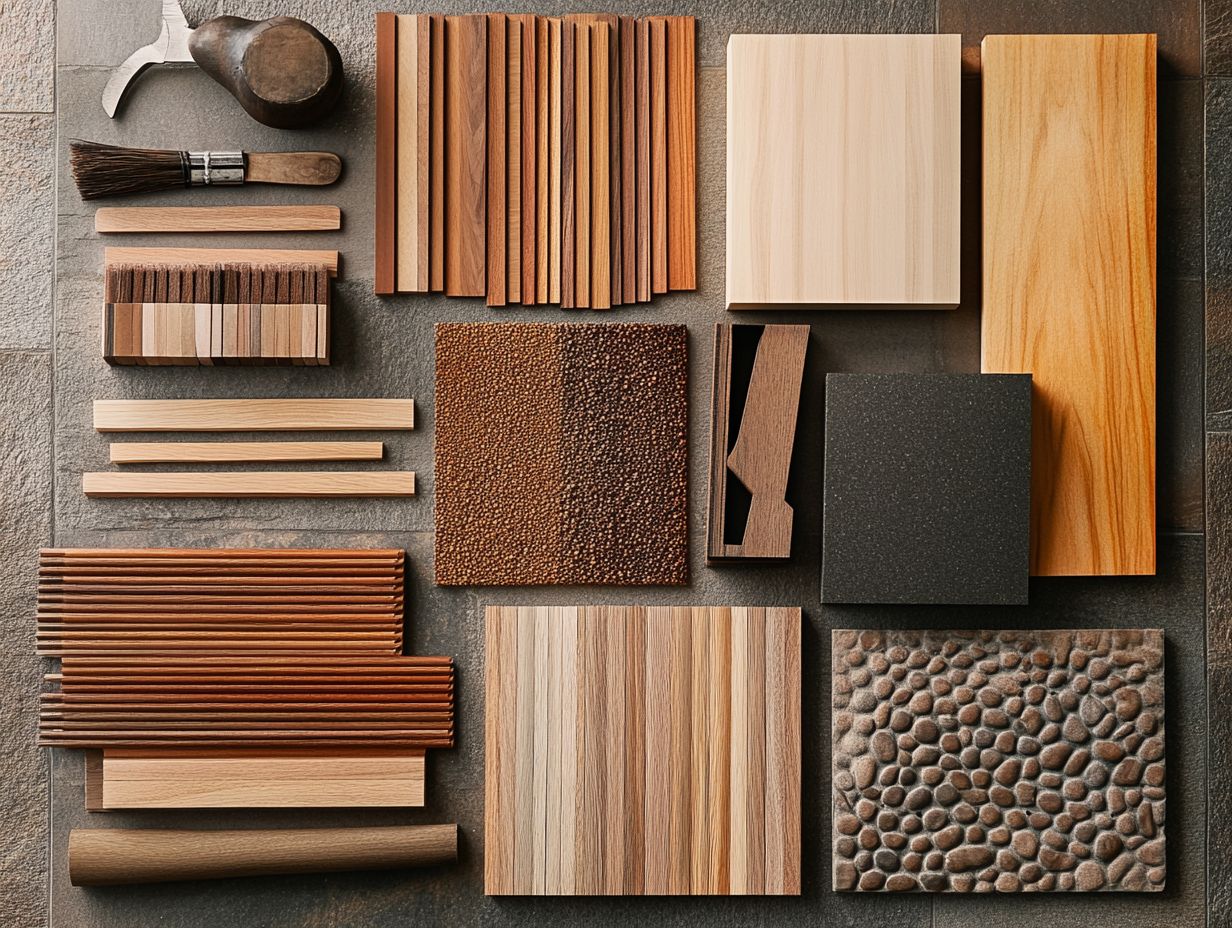
Insulation is your sauna’s best friend! It helps maintain the ideal temperature, minimizes energy costs, and enhances your overall sauna experience.
By choosing materials like fiberglass insulation or foam boards, you can significantly improve thermal efficiency. A proper moisture barrier is also essential to prevent water damage and protect your wooden structures.
Choosing the right insulation materials boosts performance and contributes to the longevity and ease of maintenance of your sauna, ensuring it remains a relaxing retreat for years to come.
Ready to start building your dream sauna? Let s get started!
Which Insulation is Most Effective?
When selecting insulation for your sauna, fiberglass insulation stands out as one of the most effective choices. It offers exceptional thermal performance and moisture resistance.
By installing a proper vapor barrier alongside the insulated walls, you enhance energy efficiency and protect the sauna’s wooden structure from humidity. This leads to a more enjoyable sauna experience.
While other insulation materials like foam or cellulose may have certain benefits, they typically don’t match fiberglass in striking the right balance between thermal insulation and moisture control.
Specifically, fiberglass insulation excels at reducing heat loss and maintains its effectiveness over time. This is crucial for keeping a stable and comfortable temperature within your sauna.
A vapor barrier is crucial; it acts as a protective shield against condensation, safeguarding the integrity of the wooden components. This ensures you can fully enjoy your sauna time without worrying about mold or decay.
Heating Options for Saunas
Choosing your sauna’s heating option excites exploration into how to enhance your experience! There is a range of heater types designed to meet your specific desires.
Traditional saunas often rely on electric or gas heaters, creating a classic steam-filled atmosphere that many cherish.
On the other hand, infrared heaters present a distinctive approach by warming your body directly, bypassing the need to heat the air. This innovative method is becoming popular among those who seek an alternative sauna experience.
Comparing Traditional and Infrared Heaters
When weighing the options between traditional and infrared heaters, it s essential to recognize the distinct benefits each can bring to your sauna experience. Traditional heaters evoke a classic steam bath ambiance, perfect for social gatherings and deep relaxation.
Infrared heaters offer direct body warmth, catering to those who prefer a gentler environment and quicker heating times.
If you re in search of a soothing atmosphere, traditional heaters excel at creating a humid, invigorating space steeped in sauna culture. The delightful aroma of cedar wood often enhances this experience.
On the other hand, if you appreciate the ease of modern technology, infrared heaters might catch your interest. They heat up swiftly, allowing you to dive right in without the lengthy wait times that come with traditional methods.
This quick heating is a game-changer for those with busy schedules. Moreover, infrared units frequently highlight their health benefits, including improved circulation and detoxification, which refers to the body’s process of removing toxins. It s no wonder they re gaining popularity among health-conscious sauna lovers.
Other Essential Materials for Saunas

In addition to wood and insulation, you’ll find that other essential materials play a pivotal role in enhancing both the functionality and aesthetic appeal of your sauna.
High-quality benching, sturdy flooring, and well-considered lighting elements are crucial components that elevate the sauna experience, transforming it into a welcoming oasis for relaxation.
By selecting these materials thoughtfully, you not only enhance the ambiance but also simplify maintenance, ensuring that your sauna remains a durable and inviting sanctuary for years to come.
Benching, Flooring, and Lighting
The selection of benching, flooring, and lighting is crucial in shaping your sauna experience. It influences both comfort and ambiance. Thoughtfully designed benches ensure comfortable seating for gatherings or moments of solitude.
Durable flooring materials prioritize safety and ease of maintenance. Carefully chosen lighting creates an inviting atmosphere, enhancing the sense of community within the sauna.
These elements synchronize to deliver a complete sensory experience, where warmth envelops you and aesthetics calm your mind. Benches made of high-quality wood not only provide ergonomic support but also release a delightful aroma, fostering a natural, healing environment.
Your choice of flooring be it traditional wood or sleek contemporary tiles can enrich the sauna s character. It also helps to ensure grip and stability in humid conditions. Ambient lighting transforms the mood, setting the perfect vibe for quiet reflection or energizing social interactions. This makes the sauna a versatile sanctuary for any occasion.
Maintaining and Replacing Sauna Materials
Regular maintenance and timely replacement of sauna materials are essential to keep your sauna experience safe and enjoyable. By implementing precautions such as routine cleaning and inspections, you can prevent wear and damage.
This approach extends the lifespan of key components like benches, flooring, and heaters. It’s crucial for every sauna owner to understand these best practices for maintaining their materials.
By doing so, your sanctuary continues to provide relaxation and comfort for years to come.
Tips for Cleaning and Upkeep
Effective cleaning and maintenance are vital for preserving the integrity and safety of your sauna. They enhance its aesthetic appeal and functionality. Regularly clean surfaces and inspect the heater and insulation for wear.
To achieve optimal results, consider establishing a routine. This should include weekly sweeping and monthly deep cleaning to tackle dust and grime. Soft scrub brushes and mild detergents work wonders on wooden surfaces.
High-heat disinfectants are ideal for any metal components. Pay special attention to the benches, as moisture can lead to mold if they aren’t properly dried after each use.
Periodically inspecting the sauna s vents and drainage system ensures optimal airflow. This protects your materials from excess moisture buildup.
By incorporating these straightforward practices, you enjoy a cleaner environment and contribute to a more enjoyable and healthier sauna experience.
Frequently Asked Questions
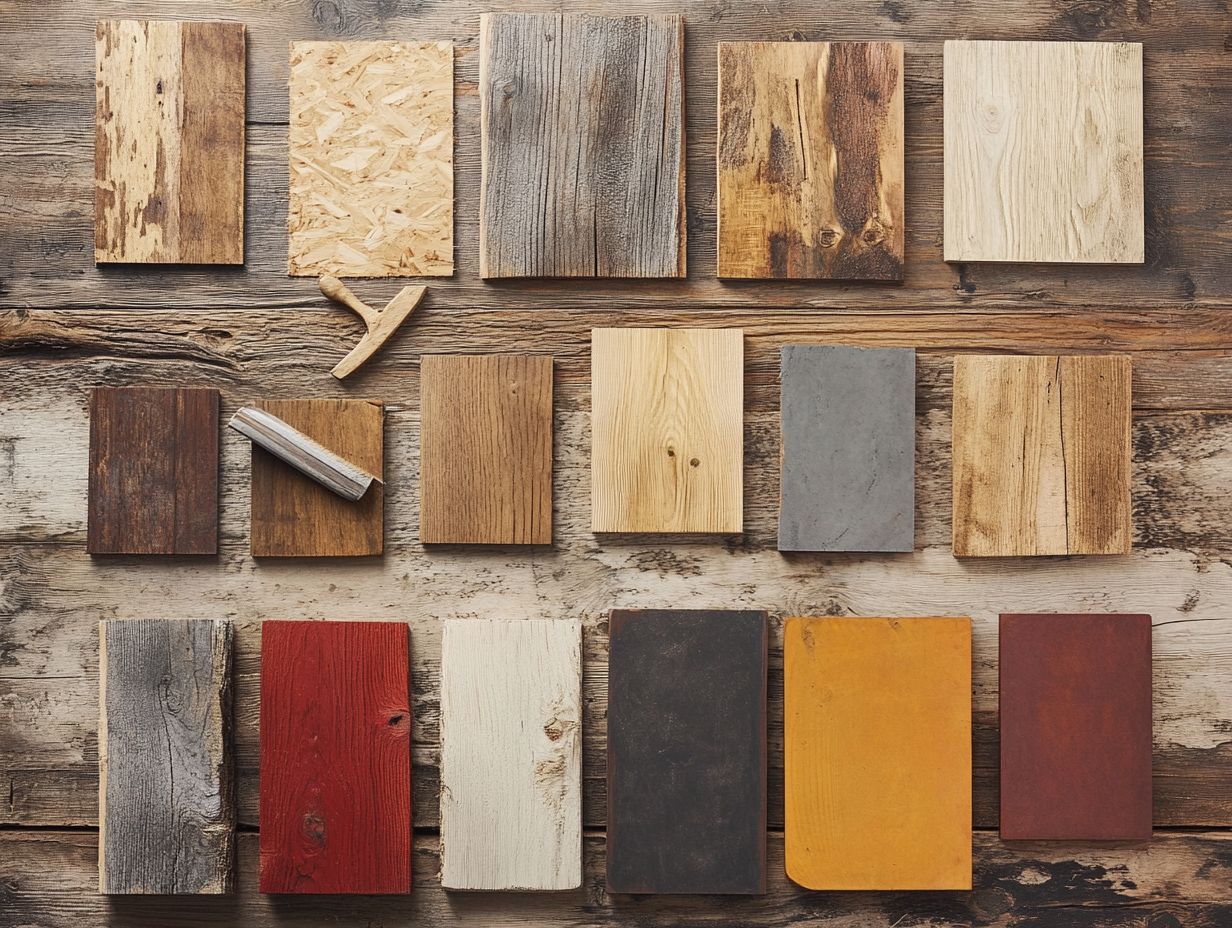
What are the best materials for building a sauna?
The best materials include cedar wood, aspen wood, and redwood. These woods are resistant to heat and moisture, making them ideal for sauna construction.
Why is cedar wood a popular choice for saunas?
Cedar wood is favored for its lovely scent and natural resistance to heat. It also has a beautiful appearance that adds to the overall aesthetic of the sauna.
What makes aspen wood a good option for sauna building?
Aspen wood is a great choice due to its light color and resistance to warping. Its smooth surface is comfortable to sit on, making it perfect for sauna benches.
Can redwood be used for both indoor and outdoor saunas?
Yes, redwood is versatile and can be used for both indoor and outdoor saunas. Its natural resistance to decay and insects makes it suitable for outdoor use. Its beautiful color and scent also make it a popular choice for indoor saunas.
Ready to elevate your sauna experience? Contact us today!
Are there other materials for building a sauna besides wood?
Wood is the most common material for sauna construction. However, you can also use ceramic tiles, glass, or even metal for a modern touch.
These materials might look sleek, but they don t offer the same natural benefits that wood provides.
What should I consider when choosing the best materials for my sauna?
Think about heat resistance, moisture resistance, and durability when selecting materials.
Keep your budget in mind and aim for a look that fits your style!


